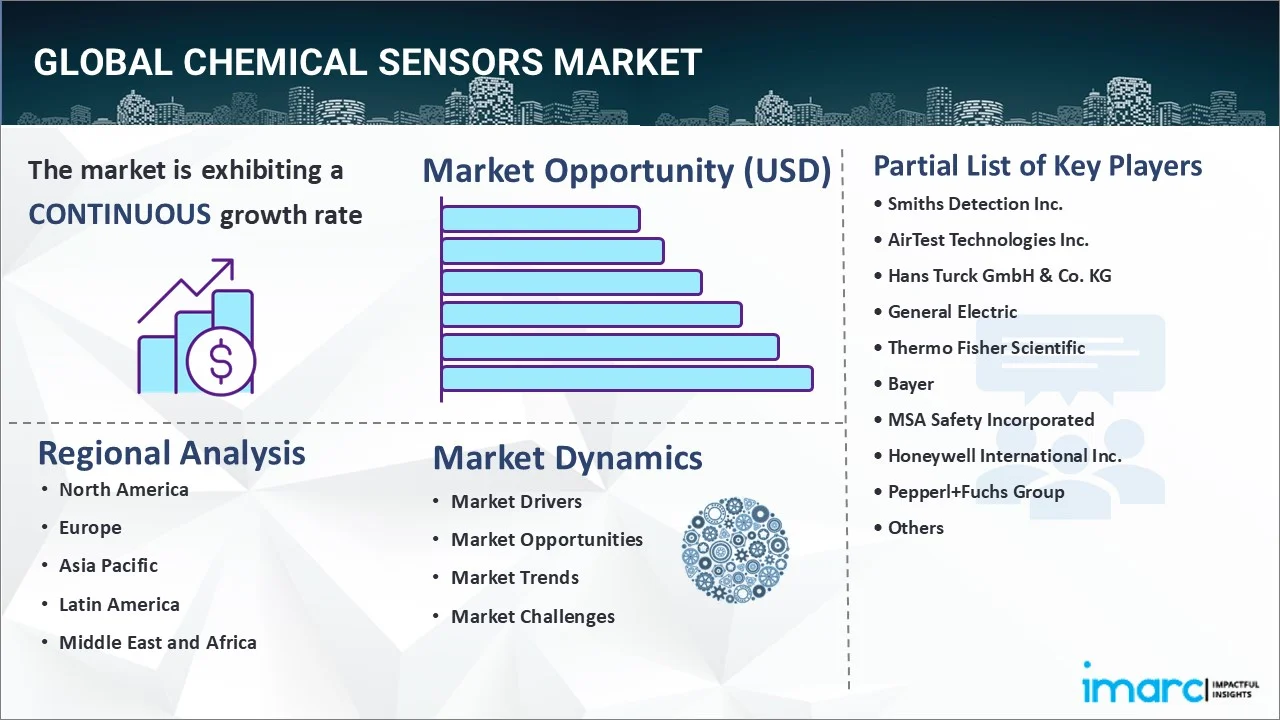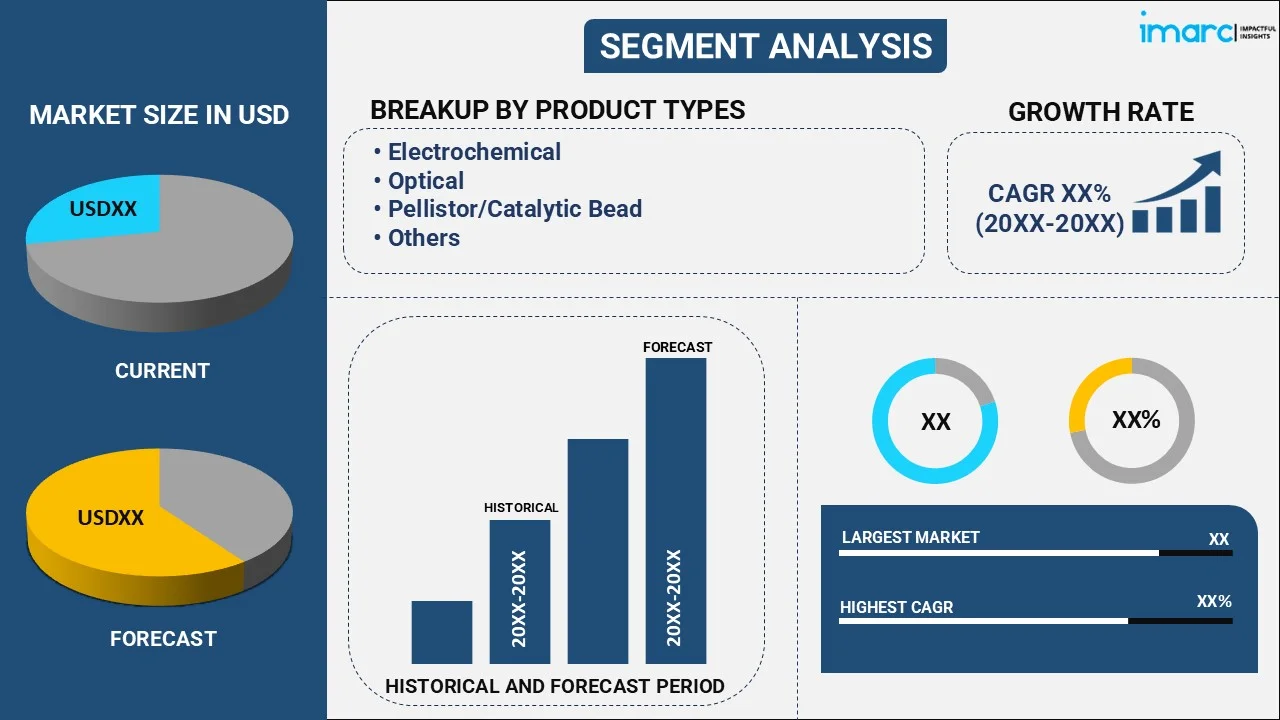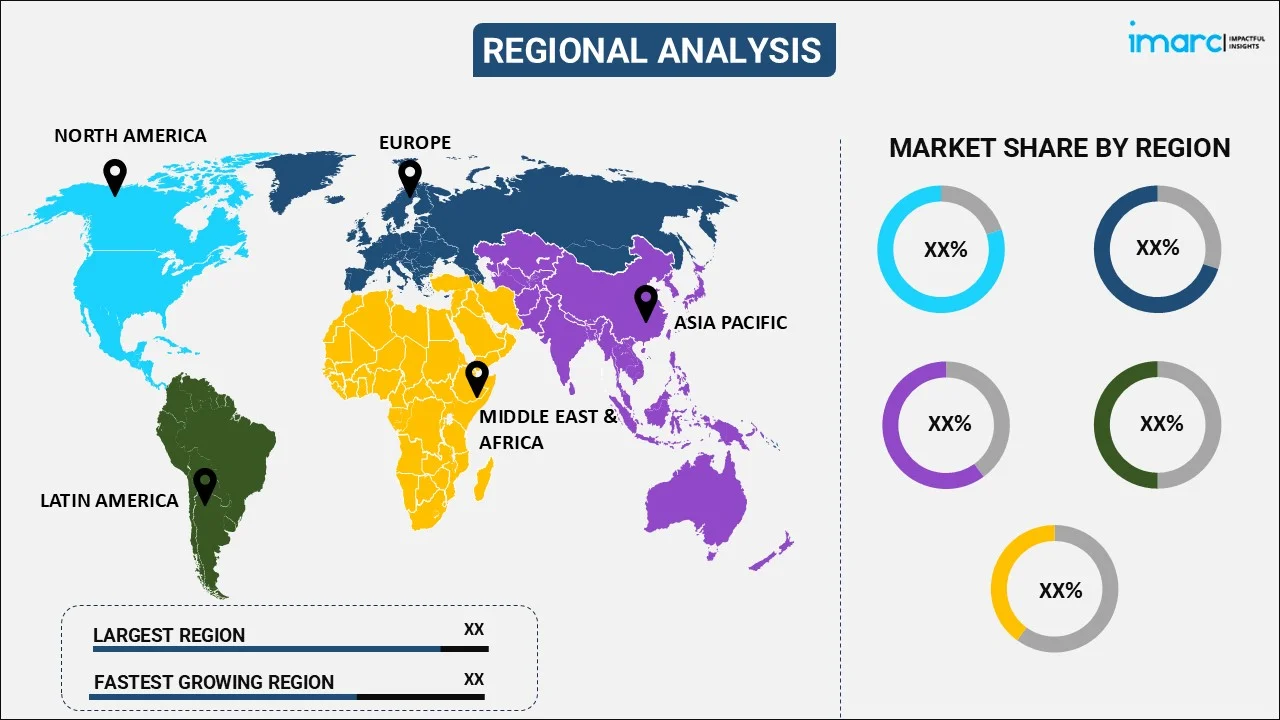
Chemical Sensors Market Report by Product Type (Electrochemical, Optical, Pellistor/Catalytic Bead, Semiconductor, and Others), Analyte (Solid, Liquid, Gas), Application (Industrial, Environmental Monitoring, Medical, Defense and Homeland Security, and Others), and Region 2025-2033
Chemical Sensors Market Size:
The global chemical sensors market size reached USD 25.4 Billion in 2024. Looking forward, IMARC Group expects the market to reach USD 40.9 Billion by 2033, exhibiting a growth rate (CAGR) of 5.18% during 2025-2033. The global market is rapidly expanding, driven by the rising demand for environmental monitoring, healthcare applications, and industrial safety. Advancements in nanotechnology and IoT integration further propel growth. At present, North America dominates the market, supported by robust technological infrastructure, strong regulatory frameworks, and significant investments in research and development (R&D).
|
Report Attribute
|
Key Statistics
|
|---|---|
|
Base Year
|
2024 |
|
Forecast Years
|
2025-2033
|
|
Historical Years
|
2019-2024
|
| Market Size in 2024 | USD 25.4 Billion |
| Market Forecast in 2033 | USD 40.9 Billion |
| Market Growth Rate (2025-2033) | 5.18% |
Chemical Sensors Market Analysis:
- Major Market Drivers: The market is driven by continuous advancements in sensor technology, such as miniaturization and wireless capabilities, which enhance functionality and application range. In addition to this, increasing regulatory pressure on environmental monitoring and safety across industries fuels the demand for accurate, real-time detection of pollutants and hazardous substances, supporting the market expansion.
- Key Market Trends: Rising demand for environmental monitoring technologies is fueling product adoption, particularly in detecting air, water, and soil pollutants. In line with this, rising product integration in healthcare applications like clinical diagnostics and patient monitoring is fostering market growth. Moreover, the expansion of industrial automation, leading to the adoption of sensors in manufacturing, safety, and process control is positively impacting the chemical sensors industry outlook.
- Geographical Trends: North America leads the chemical sensors market due to its advanced technological infrastructure and strict regulatory environment, driving high demand for sophisticated sensors across industries. In line with this, Europe follows significant growth driven by its focus on environmental and safety standards and technological advancements. Furthermore, the Asia-Pacific region is also experiencing rapid growth due to industrial expansion, extensive investments in smart manufacturing, and a rising focus on pollution control and safety measures.
- Competitive Landscape: Some of the major market players in the chemical sensors industry include Smiths Detection Inc., AirTest Technologies Inc., Hans Turck GmbH & Co. KG, General Electric, Thermo Fisher Scientific, Bayer, MSA Safety Incorporated, Honeywell International Inc., Pepperl+Fuchs Group, SICK AG, Siemens AG, ABB Ltd, SenseAir AB, Spectris PLC, Denso Corporation, Halma PLC, Owlstone Inc., among many others.
- Challenges and Opportunities: The market faces challenges such as high costs associated with advanced sensor technologies and the need for continuous innovation to meet diverse application requirements. However, there are opportunities in emerging markets and sectors, such as smart agriculture and wearable health sensors, which offer growth potential and demand for specialized sensor solutions.

Chemical Sensors Market Trends:
Integration with Internet of Things (IoT)
The integration of chemical sensors into IoT frameworks is revolutionizing various industries by enabling real-time monitoring and seamless data exchange. This synergy allows for continuous and automated collection of environmental and industrial data, enhancing the accuracy and responsiveness of monitoring systems. For instance, in environmental management, IoT-enabled chemical sensors can detect pollutants and trigger immediate remediation actions, thereby improving public health and safety. In industrial settings, these sensors facilitate predictive maintenance by monitoring chemical processes and identifying potential issues before they escalate. Additionally, the vast data generated through IoT connectivity can be harnessed using advanced analytics and machine learning, providing deeper insights and fostering smarter decision-making. In line with this, in May 2024, Aqsen Innovations announced its partnership with CENSIS to advance its IoT sensor system, Aquasense, designed to test water quality variables like temperature, oxygenation, salinity, and chemical presence. The low-cost sensor system aims to aid developing countries in managing water quality in real time, potentially benefiting agriculture and aquaculture. These innovations and partnerships are creating a positive chemical sensors market outlook by driving widespread adoption of IoT-enabled chemical sensors across industries.
Advancements in Nanotechnology
The integration of nanomaterials like graphene and carbon nanotubes into chemical sensors significantly boosts their performance. These materials possess exceptional electrical, mechanical, and surface properties, which enhance the sensors’ ability to detect minute concentrations of analytes with high accuracy. Graphene’s large surface area facilitates greater interaction with target molecules, while carbon nanotubes improve electrical conductivity and signal transduction. According to an article published by ACS in 2023, researchers developed a self-powered nanosensor that can detect small amounts of mercury ions with just a tap. The sensor, integrated into a robotic hand, uses the triboelectric effect to generate electricity and signal the presence of mercury ions. It is highly selective and can detect ions in water and food samples. This increased sensitivity and specificity enable the detection of trace levels of chemicals, making sensors more reliable for applications in environmental monitoring, healthcare, and industrial safety.
Environmental Monitoring and Safety Applications
The surge in environmental regulations globally is significantly boosting the adoption of chemical sensors, as industries strive to comply with stringent air and water quality standards. Real-time monitoring capabilities enable immediate detection of pollutants, facilitating swift pollution control measures and minimizing environmental impact. For instance, in March 2024, MIT chemists developed a sensor that can detect "forever chemicals" known as PFAS in drinking water. The sensor can detect PFAS levels as low as 200 parts per trillion in a water sample, offering a faster and cheaper alternative to current detection methods. The researchers are working on a larger-scale device to increase sensitivity and envision a user-friendly household system for PFAS detection. In industrial settings, chemical sensors play a crucial role in ensuring safety by continuously tracking hazardous substances, thereby preventing accidents and protecting workers. In line with this, public health initiatives benefit from precise environmental monitoring, allowing for timely interventions to safeguard communities from harmful pollutants. This heightened focus on environmental stewardship and safety underscores the essential role of chemical sensors in promoting sustainable and healthy living environments.
Chemical Sensors Market Segmentation:
IMARC Group provides an analysis of the key trends in each segment of the market, along with forecasts at the global and regional for 2025-2033. Our report has categorized the market based on product type, analyte, and application.
Breakup by Product Type:

- Electrochemical
- Potentiometric
- Amperometric
- Conductometric
- Others
- Optical
- Infrared
- Photoionization
- Others
- Pellistor/Catalytic Bead
- Semiconductor
- Others
Electrochemical sensors hold the largest share of the industry
The report has provided a detailed breakup and analysis of the market based on the product type. This includes electrochemical (potentiometric, amperometric, conductometric, others), optical (infrared, photoionization, others), pellistor/catalytic bead, semiconductor, and others. According to the chemical sensors market research report, electrochemical sensors accounted for the largest market share.
On the basis of chemical sensors market dynamics, electrochemical sensors dominate the market owing to their high sensitivity, versatility, and cost-effectiveness. These sensors measure chemical concentrations by detecting changes in electrical properties caused by chemical reactions. They are widely used in environmental monitoring, industrial processes, and healthcare due to their ability to provide real-time, accurate readings of gases and liquids. Besides this, the demand for electrochemical sensors is also driven by their robustness and reliability in various conditions, their compatibility with different chemicals, and their relatively low maintenance needs. Along with this, ongoing advancements in technology have enhanced their performance and affordability, further contributing to the market growth.
Breakup by Analyte:
- Solid
- Liquid
- Gas
Solid accounts for the majority of the market share
A detailed breakup and analysis of the market based on the analyte have also been provided in the report. This includes solid, liquid, and gas. According to the report, solid represented the largest segment.
Based on the chemical sensors industry report, the demand for solid chemical sensors is driven by their stability, durability, and wide range of applications. These sensors utilize solid-state materials to detect chemical changes, offering high sensitivity and reliability. They are particularly valued in applications requiring long-term stability and low maintenance, such as environmental monitoring and industrial control systems. Solid chemical sensors often outperform their liquid or gas counterparts in harsh conditions, providing consistent performance with minimal drift. Moreover, significant advancements in materials science, which have enhanced their performance, reduced costs, and expanded their applications are providing an impetus to the market growth.
Breakup by Application:
- Industrial
- Motor Vehicles
- Food & Beverage Processing
- HVAC
- Environmental Monitoring
- Industrial Safety & Emissions
- Water & Wastewater
- Automotive Emissions Testing
- Medical
- Clinical Diagnostics
- Nutritional
- Defense and Homeland Security
- Others
Industrial applications represent the leading market segment
The report has provided a detailed breakup and analysis of the market based on the application. This includes industrial (motor vehicles, food & beverage processing, HVAC), environmental monitoring (industrial safety & emissions, water & wastewater, automotive emissions testing), medical (clinical diagnostics, nutritional), defense and homeland security, and others. According to the report, industrial applications accounted for the largest market share.
As per the chemical sensors market insights, sensors play a critical role in optimizing processes, ensuring safety, and maintaining quality control. These sensors are employed to monitor and control various chemical parameters, such as pH, concentration, and gas levels, in manufacturing, refining, and processing industries. Their ability to provide real-time, accurate data helps prevent equipment failures, reduce downtime, and enhance operational efficiency. Additionally, industrial chemical sensors are crucial for compliance with environmental regulations and safety standards. Consequently, the widespread demand for these sensors in industrial settings driven by the need for reliable and continuous monitoring, advancements in sensor technology, and the push for automation and smart manufacturing systems is propelling the market forward.
Breakup by Region:

- Asia Pacific
- Europe
- North America
- Middle East and Africa
- Latin America
North America leads the market, accounting for the largest chemical sensors market share
The report has also provided a comprehensive analysis of all the major regional markets, which include Asia Pacific, Europe, North America, Middle East and Africa, and Latin America. According to the report, North America represents the largest regional market for chemical sensors.
The chemical sensors market forecast shows that the North America enjoys the leading position due to its advanced industrial infrastructure, high technological adoption, and strong regulatory frameworks. The region's robust manufacturing base and emphasis on innovation drive the demand for sophisticated chemical sensors in various applications, including environmental monitoring, healthcare, and industrial processes. Additionally, stringent regulations on environmental protection and workplace safety in North America propel the adoption of chemical sensors to ensure compliance and enhance operational efficiency. The presence of leading technology companies and research institutions further drives the development and deployment of advanced sensor technologies, creating a positive outlook for market expansion.
Competitive Landscape:
The market research report has also provided a comprehensive analysis of the competitive landscape in the market. Detailed profiles of all major companies have also been provided. Some of the major market players in the chemical sensors industry include:
- Smiths Detection Inc.
- AirTest Technologies Inc.
- Hans Turck GmbH & Co. KG
- General Electric
- Thermo Fisher Scientific
- Bayer
- MSA Safety Incorporated
- Honeywell International Inc.
- Pepperl+Fuchs Group
- SICK AG
- Siemens AG
- ABB Ltd
- SenseAir AB
- Spectris PLC
- Denso Corporation
- Halma PLC
- Owlstone Inc.
(Please note that this is only a partial list of the key players, and the complete list is provided in the report.)
The competitive landscape is characterized by a diverse array of players ranging from established global giants to innovative startups. Prominent market players are investing heavily in R&D to drive innovation in sensor technologies, such as miniaturization and enhanced sensitivity. Concurrently, smaller and specialized firms focus on niche applications and emerging technologies, including wearable sensors and integrated sensor systems. The competition is further intensified by the rapid pace of technological advancements and increasing chemical sensors market revenue in diverse applications such as environmental monitoring, industrial automation, and healthcare. This dynamic environment fosters continuous improvement and innovation in chemical sensing technologies.
Chemical Sensors Market News:
- In June 2024, Baker Hughes announced the launch of three new sensor technologies for gas, flow, and moisture measurements, aimed at enhancing safety and productivity in oil and gas, hydrogen, and other industrial applications. The new Panametrics solutions offer advanced accuracy, reliability, and durability. These technologies are designed to operate in harsh environments and can be used in sectors such as oil and gas, hydrogen, metals, chemicals, biogas, power generation, and CCUS.
- For instance, in April 2024, onsemi introduced the CEM102, a cutting-edge analog front-end (AFE) that enables precise electrochemical sensing with minimal power consumption. This miniaturized solution is ideal for industrial, environmental, and healthcare applications, offering unmatched accuracy in measuring biochemicals, air quality, gases, and hazardous chemicals. Designed to work seamlessly with the RSL15 Bluetooth® 5.2 enabled microcontroller, it provides industry-leading power efficiency and wide supply voltage range, making it suitable for battery-operated sensors.
Chemical Sensors Market Report Scope:
| Report Features | Details |
|---|---|
| Base Year of the Analysis | 2024 |
| Historical Period | 2019-2024 |
| Forecast Period | 2025-2033 |
| Units | Billion USD |
| Scope of the Report | Exploration of Historical Trends and Market Outlook, Industry Catalysts and Challenges, Segment-Wise Historical and Future Market Assessment:
|
| Product Types Covered |
|
| Analytes Covered | Solid, Liquid, Gas |
| Applications Covered |
|
| Regions Covered | Asia Pacific, Europe, North America, Latin America, Middle East and Africa |
| Companies Covered | Smiths Detection Inc., AirTest Technologies Inc., Hans Turck GmbH & Co. KG, General Electric, Thermo Fisher Scientific, Bayer, MSA Safety Incorporated, Honeywell International Inc., Pepperl+Fuchs Group, SICK AG, Siemens AG, ABB Ltd, SenseAir AB, Spectris PLC, Denso Corporation, Halma PLC, Owlstone Inc., etc. |
| Customization Scope | 10% Free Customization |
| Post-Sale Analyst Support | 10-12 Weeks |
| Delivery Format | PDF and Excel through Email (We can also provide the editable version of the report in PPT/Word format on special request) |
Key Benefits for Stakeholders:
- IMARC’s industry report offers a comprehensive quantitative analysis of various market segments, historical and current market trends, market forecasts, and dynamics of the chemical sensors market from 2019-2033.
- The research report provides the latest information on the market drivers, challenges, and opportunities in the global chemical sensors market.
- The study maps the leading, as well as the fastest-growing, regional markets.
- Porter's five forces analysis assists stakeholders in assessing the impact of new entrants, competitive rivalry, supplier power, buyer power, and the threat of substitution. It helps stakeholders to analyze the level of competition within the chemical sensors industry and its attractiveness.
- The competitive landscape allows stakeholders to understand their competitive environment and provides insight into the current positions of key players in the market.
Key Questions Answered in This Report
The global chemical sensors market was valued at USD 25.4 Billion in 2024.
We expect the global chemical sensors market to exhibit a CAGR of 5.18% during 2025-2033.
The rising utilization of chemical sensors across numerous industries, including automotive, oil and gas, military and defense, etc., as they offer excellent accuracy and real-time information regarding a sample, is primarily driving the global chemical sensors market.
The sudden outbreak of the COVID-19 pandemic had led to the implementation of stringent lockdown regulations across several nations, resulting in the temporary closure of various end-use industries for chemical sensors.
Based on the product type, the global chemical sensors market can be categorized into electrochemical, optical, pellistor/catalytic bead, semiconductor, and others. Currently, electrochemical sensor accounts for the majority of the global market share.
Based on the analyte, the global chemical sensors market has been segregated into solid, liquid, and gas. Among these, solid currently exhibits a clear dominance in the market.
Based on the application, the global chemical sensors market can be bifurcated into industrial, environmental monitoring, medical, defense and homeland security, and others. Currently, industrial holds the largest market share.
On a regional level, the market has been classified into Asia Pacific, Europe, North America, Middle East and Africa, and Latin America, where North America currently dominates the global market.
Some of the major players in the global chemical sensors market include Smiths Detection Inc., AirTest Technologies Inc., Hans Turck GmbH & Co. KG, General Electric, Thermo Fisher Scientific, Bayer, MSA Safety Incorporated, Honeywell International Inc., Pepperl+Fuchs Group, SICK AG, Siemens AG, ABB Ltd, SenseAir AB, Spectris PLC, Denso Corporation, Halma PLC, Owlstone Inc., etc.
Need more help?
- Speak to our experienced analysts for insights on the current market scenarios.
- Include additional segments and countries to customize the report as per your requirement.
- Gain an unparalleled competitive advantage in your domain by understanding how to utilize the report and positively impacting your operations and revenue.
- For further assistance, please connect with our analysts.
 Request Customization
Request Customization
 Speak to an Analyst
Speak to an Analyst
 Request Brochure
Request Brochure
 Inquire Before Buying
Inquire Before Buying




.webp)




.webp)












